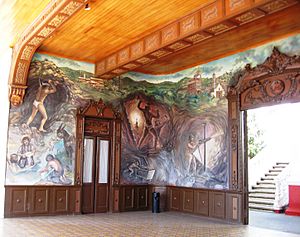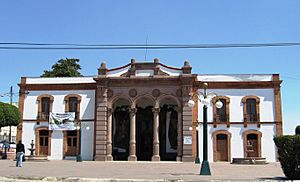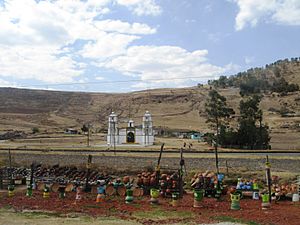El Oro de Hidalgo facts for kids
Quick facts for kids
El Oro
|
|
|---|---|
|
Municipality
|
|
 |
|
| Country | |
| State | State of Mexico |
| Municipality | El Oro |
| Municipal seat | El Oro de Hidalgo |
| Town Founded | 1787 |
| Municipality Founded | 1901 |
| Area | |
| • Municipality | 137.86 km2 (53.23 sq mi) |
| Elevation
(of seat)
|
2,740 m (8,990 ft) |
| Population
(2005) Municipality
|
|
| • Municipality | 31,847 |
| • Seat | 5,797 |
| Time zone | UTC-6 ( Central (US Central)) |
| Postal code (of seat) |
50600
|
| Website | eloromexico.gob.mx |
El Oro is a municipality in the State of Mexico, Mexico. Its main town is called El Oro de Hidalgo. The name "El Oro" means "the gold" in Spanish. It also has an old Nahuatl name, "Teocuitlatl," which also relates to gold. The municipality's symbol looks like an Aztec picture. It shows gold and caves, because there are many caves in the area.
El Oro is in the northwest part of the State of Mexico. It is about 96 kilometers (60 miles) from Toluca, the state capital. In 2005, the town of El Oro de Hidalgo had about 5,797 people. The whole municipality had 31,847 people. For a long time, El Oro was famous for its gold and silver mines. But the mines have run out of metal. Now, the town is focusing on tourism to help its economy grow.
Contents
Discovering El Oro's Past
Early History and Mining Beginnings
The Mazahua people were the first to live in this area. They moved here from the north a very long time ago. One record says they arrived in 538 AD. The first Mazahua groups settled in places like Tapaxco and Santiago Oxtempan. These places are still part of El Oro today.
At first, the Mazahuas hunted and gathered food. Later, they also started farming and fishing. Over time, other groups like the Toltecs and Aztecs ruled this region. The Aztecs conquered the area in 1474.
Before the Spanish Conquest of Mexico, there was no town where El Oro is now. Also, its gold was not yet found. Gold was being mined nearby in Tlalpujahua. This brought the Spanish to the region. Some gold was found early in the Spanish colonial period, but it was not fully explored.
Gold was the reason the town of El Oro started. One of its first names was "El Real de El Oro." This was a mining community. There are different stories about how the town was founded. One story says the Mondragón family found gold. A child showed them a shiny rock, which was quartz with gold inside. This led them to the gold vein.
El Oro was founded in 1787 by miners. They bought the land from a large farm called Hacienda of Tultenango. At first, El Oro was part of another area called Ixtlahuaca. But when gold was found, the land became property of the Spanish Crown. In 1793, the mining community became a municipality. This meant it had its own local government. It also gained control over nearby communities and mining rights.
Growth and Foreign Influence
About 22 years after gold was found, a count named Revillagigedo hired an engineer. This engineer, Manuel Agustín Mascaró, helped plan the town. El Oro became an important source of gold and silver. But it was hard to get food and supplies because of the rocky land. El Oro's first church was built in 1791.
Miguel Hidalgo's army passed through El Oro on its way to Mexico City. After Mexico became independent, engineers and investors worked to restart the mines. They used money from British companies. One company, the Tlalpuajuhua Company, reopened many mines.
Before Mexico's independence, the mines in El Oro were very busy. But they mostly closed during the war. By 1825, most of the mining here was controlled by English companies. This brought many foreigners, mostly English and French, to El Oro. They influenced the town's culture and architecture. This led to the building of beautiful buildings like the municipal palace and the Juárez Theater.
Foreign investment grew a lot in the late 1800s and early 1900s. New technologies arrived, like a train line and electricity. These changes made El Oro the most important center in the area. A new gold vein, called Esperanza, was discovered. This made the town's population grow even more. El Oro officially became the head of the municipality in 1901 and 1902. It was given the name El Oro de Hidalgo. In 1905, the world's longest power line was built. It brought electricity from Necaxa to El Oro, covering 270 km (168 miles). Parts of this old power line are still used today!
The End of Mining and New Beginnings
In 1926, many mines in El Oro started to produce less. They said the gold and silver were running out. The situation got worse in 1937 when the mining companies were taken over by the government. Soon, only one mine, Dos Estrellas, was still working. It closed in 1958.
By the mid-1900s, El Oro had only about 2,500 people. Since then, the town's economy has changed. It now focuses on shops, small factories, and handmade crafts.
Exploring El Oro's Landmarks
Municipal Palace: A Mix of Styles
The Municipal Palace is where the local government works. The first palace was made of wood in 1829. The current one opened in 1910. This building is special because it mixes two styles: Neoclassic and Art Nouveau. This mix shows the influence of the English and French people who lived here. The two towers are English in style. The front of the building has a balustrade, lamps, and fences that look Neoclassic. Inside, the main hall is Art Nouveau. Most of the building is still in its original condition. On each side of the main entrance, there is a mural by Manuel D´Rugama. It is called "The Genesis of the Miner."
Juárez Theater: A Stage for Stars
The Juárez Theater is built in the French Neoclassic style. When mining was at its peak, famous performers came to this theater. Stars like Ángela Peralta and Enrico Caruso performed here in the early 1900s. The inside of the theater has a Moorish design. It has beautiful gold decorations that are typical of Art Nouveau. The side booths are made of carved wood.
Old Train Station: A Link to the Past
The train station was finished in 1899. President Porfirio Díaz opened it. Its design is typical of that time, but also shows English influence. The train line was built for the mines. It carried both goods and people. The first owner of the line was the Manning Gold Company. Next to the station, there is an old train car. It is now a restaurant and has old photos from the town's mining days.
Mining Museum: A Look Back at Gold
The Mining Museum tells the story of El Oro's mining history. It was one of Mexico's most productive mining areas. The museum is located at an old mine shaft. It has photos from famous mines like La Esperanza. You can also see old mining machines and samples of minerals.
Local Flavors and Fun
Delicious Local Food
El Oro has many tasty traditional dishes. These include:
For sweets, there is "cola de macho." It is made from dried fruit and a type of brown sugar called piloncillo.
Local drinks include pulque, a traditional Mexican drink. There are also two unique local drinks:
- "Sende choo," a fermented corn drink.
- "Agua de sambumbia," made from fermented pineapple skins.
A special drink in El Oro is called "chiva." Miners often drank it from the mid-1800s to the mid-1900s. People believed it helped calm nerves and was good for health. A bar owner named Jacobita Galán Archundia created it. She mixed medicinal herbs into an alcoholic drink. Each family or place that makes "chiva" has its own secret recipe. It often includes herbs like prodigiosa and anise.
Festivals and Celebrations
The town of El Oro has two main festivals:
- Carnival: Celebrated with costumes and parades. There are also charreada rodeos and horse races.
- Feast Day of the Virgin of Guadalupe: This is the feast day for the town's main church. People have processions and fireworks. Traditional indigenous dances are also performed.
Exploring the El Oro Municipality
The town of El Oro de Hidalgo is the main center for the whole municipality. The municipality includes many smaller communities. The total area of the municipality is about 137.86 square kilometers (53.23 sq mi).
The municipality is located in the Sierra Madre Occidental mountains. The highest point is "La Somera" at 3,200 meters (10,500 feet). El Oro has many natural water sources. There are 36 springs, 7 deep wells, 54 small streams, 18 dams, and 5 aqueducts. The main river is called "El Oro" or "San Juan." Its water level changes a lot between the rainy and dry seasons.
About 37% of the land is used for farming. Farmers usually grow small amounts of crops for their own use. Some livestock, like dairy cows and pigs, are also raised here. There are also some small factories and shops, mostly in the main town.
Since mining ended, people in the countryside have focused on logging, stonework, and crafts. More recently, tourism is growing. People come to enjoy the beautiful nature and the interesting old buildings in the towns.
Monarch Butterfly Sanctuary
Near the town of El Oro, there is the San José del Rincon Monarch Butterfly Sanctuary. Monarch butterflies come here from November to March. The sanctuary has simple places to stay and restaurants. You can also rent horses and find trained guides. There are also vendors selling handmade crafts. The sanctuary teaches people about protecting the monarch butterfly.
Brockman Dam: Nature and Fun
The Brockman Dam is about 4 kilometers (2.5 miles) south of El Oro. It was built to hold water for the mines and homes. Today, it is a popular spot for ecotourism. You can go camping, have picnics, and fish for rainbow trout. It is a peaceful place, surrounded by pine and cedar trees. You can also rent rustic cabins here.
There is also an unexplored archaeological site between Endotejiare and Tapaxco.
See also
 In Spanish: El Oro de Hidalgo para niños
In Spanish: El Oro de Hidalgo para niños








